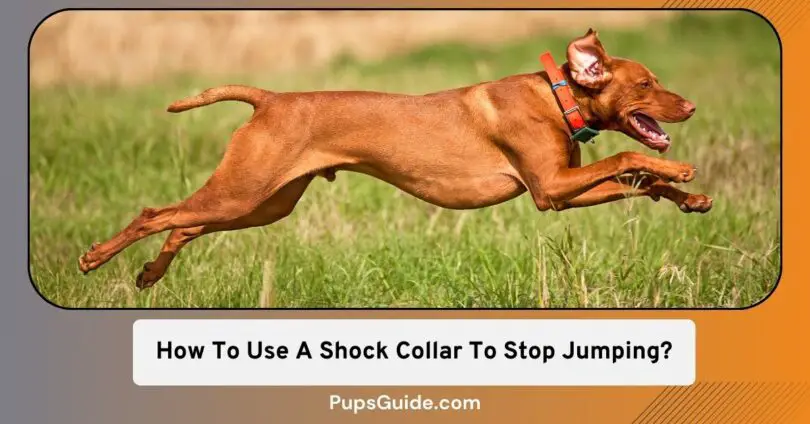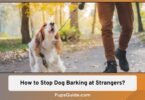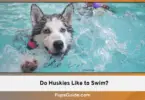Ever wondered why your furry friend turns into a furry missile upon seeing you? Dogs jump for joy, affection, and a whole lot of excitement. Decoding the canine mind reveals a lot of reasons behind this classic behavior.
Now, if you’re considering using a training shock collar to curb these aerial acrobatics, fear not – I’ve got a step-by-step guide. Throw in a leash for good measure, and you’ll be controlling your pet in no time.
Here’s how to use a shock collar to stop jumping (with a leash).
But first…
Why Do Dogs Jump On People?
The classic doggy high-five – jumping up to greet us mere mortals. Dogs are social creatures, and their jumping antics usually come from a place of excitement, affection, or a bit of both. Let’s decode the canine mind:
1. Excitement Overload
Dogs are like walking bundles of enthusiasm. When they see someone they love (which is basically everyone they meet), the excitement meter goes through the roof. Jumping is their way of saying, “You’re the best thing since sliced bones!”
2. Attention, Please
Your dog is jumping, and you’re reacting – be it with laughter, scolding, or attempts to escape the airborne assault. For dogs, any attention is good attention. They might interpret your reaction as a big win.
3. Pack Hierarchy Vibes
In the wild, lower-ranking members jump to greet the alpha. Your dog sees you as the top dog (or alpha human, if you will). Jumping is their way of acknowledging your superior status and seeking approval.
4. I Just Wanna Say Hi
Dogs explore the world with their noses, and when they jump, they’re aiming for face-to-face interaction. It’s their way of extending a friendly pawshake and getting up close and personal.
5. Impulse Control? What’s That?
Patience isn’t always a dog’s strong suit. They see someone they adore, and BAM! Gravity takes a backseat. It’s a challenge for them to contain their excitement, especially in the presence of their favorite humans.
6. Puppy Habits Die Hard
Puppies jump on their moms and littermates for attention. As they grow, they might transfer this behavior to the humans in their lives. It’s like a leftover habit from the puppy playbook.
7. Expressing Joy and Happiness
Dogs wear their hearts on their furry sleeves. Jumping is their way of expressing sheer joy and happiness at seeing you. It’s like a doggy dance of delight.
8. A Bit of FOMO
Fear of missing out isn’t exclusive to humans. When your dog sees someone getting a hug or a pat, they might jump in, thinking they’re missing out on the party. It’s their way of saying, “Include me, too!”
9. It’s Instinctive
Sometimes, jumping is just hardwired into a dog’s DNA. It’s a natural behavior that they might not even think about – it just happens.
10. Testing Boundaries
Dogs are clever beings. Jumping can be a way for them to test the waters and see what kind of reaction they get. If they get a positive response, they might keep it in their repertoire.
Understanding the why behind the jump can help you address the behavior effectively. So, next time your dog turns into a furry missile, remember it’s just their way of telling you that you are their favorite human ever.
How To Use A Shock Collar To Stop A Dog From Jumping?
Let’s talk about using a shock collar to curb those airborne canine acrobatics. Here’s how to do it. You’ll use a leash with a collar to fortify the training and give your dog a direction to follow.
Step #1: Get the Right Gear
Before you go zapping your furry friend, make sure you’ve got a shock collar and a leash that’s appropriate for your dog’s size.
Step #2. Read the Manual (Yeah, Seriously)
I know, reading manuals can be as fun as watching paint dry, but trust me on this one. Each shock collar is different, and you don’t want to turn your pup into a four-legged lightning rod by pressing the wrong buttons.
Step #3: Introduce the Collar and The Leash
Let your pup become familiar with the gear. It’s like getting used to a new accessory. Maybe throw in a treat or two to make it a positive experience—dogs, like humans, appreciate a good treat!
Step #4. Achieve the Right Fit
Just like your favorite pair of jeans, the tools need to fit just right. Not too loose, not too tight – you want the perfect levels of comfort.
Step #5. Leash and Collar Combo
Snap-on the leash and collar without activating the shock. This is like a dress rehearsal for the main event. Let your dog strut their stuff and get used to the feeling of being on a leash.
Step #6. Leash in Action
Keep that leash short and sweet. When your dog gets that jumping itch, give a gentle tug on the leash. Think of it as a polite “Hey, we’re not auditioning for the circus today.”
Step #7. Mix In The Shock Collar
Rome wasn’t built in a day, and your dog’s behavior won’t change overnight. Ease into the training.
Start with the lowest setting and work your way up if needed. Identify the intensity level that works for your dog.
Think of it like tuning a radio station—find that sweet spot where it’s effective but not overwhelming. You’re aiming for a smooth melody, not a screechy tune.
You’re supposed to zap the dog when you pull the leash gently.
Step #8. Timing is Everything
Like telling a joke, timing is key here, too. When your dog starts their best kangaroo impersonation, hit the button and pull the leash at the same time. This creates a connection between the jumping and your response.
Step #9. Pair it with Commands
Dogs are smart cookies. Associate your response with a command like “down” or “no jump.” This way, they’ll start connecting the dots between the zap and the unwanted behavior.
Step #10. Mix in the Treats
Positive reinforcement is like the sugar in your morning coffee—it makes everything better. Shower your pup with treats and praise when they follow the rules. They’ll be more likely to stick to the program.
Step #11. Be Consistent
Consistency is key. Use the shock collar every time your pup goes for the high jump. Soon enough, they’ll start associating their Olympic-style leaps with a not-so-fun surprise.
Step #12. Stay Calm and Cool
Dogs can sense your feelings. Stay calm during the training. If you’re all frazzled, your pup will pick up on it, and the shock collar might become a source of anxiety.
Step #13. Know When to Call It Quits
If your dog is just not getting the memo or is showing signs of stress, it might be time to stop. There are plenty of other positive reinforcement techniques out there.
Remember, training takes time, patience, and a sprinkle of humor. It’s a journey, not a sprint.
Why Using a Leash Works Wonders With A Training Collar?
Using a leash alongside a shock collar can be a tag team duo when it comes to teaching your dog the no-jump tango.
1. Guided Learning
The leash helps guide your dog into the right behavior. When they’re about to take flight, a gentle tug on the leash can redirect their energy and remind them of the ground rules.
2. Physical and Mental Connection
Dogs are all about making connections. The leash becomes a tangible link between their actions and your guidance.
3. Helps In Timing Your Response
Remember the importance of timing? The leash gives you precise control over your pup’s movements, allowing you to sync up the shock with their attempt at defying gravity.
4. Consistency Booster
Consistency is like the secret sauce in dog training. The leash helps maintain a consistent training environment, reinforcing the message that jumping equals a not-so-pleasant consequence.
5. Added Safety Net
Dogs, especially the energetic ones, can be a bit unpredictable. The leash acts as a safety net, preventing any impromptu circus acts that might lead to injury or chaos.
6. Controlled Interactions
Whether you’re introducing your pup to new people or other dogs, the leash gives you the upper hand in controlling their behavior. No surprise leaps mean smoother social interactions.
Conclusion
Understanding why dogs jump is the first step to tackling the issue, and using a shock collar with a leash can be a powerful combo to teach your dog some ground manners. Remember, it’s not about being the doggy police but guiding them with love and consistency.
So, gear up, follow the steps, and turn your dog’s high-fives into low-key lounging. With a bit of patience and a dash of humor, you’ll be there soon.
I hope this guide about How To Use A Shock Collar To Stop Jumping was helpful to you.
Good Luck 🤞.








Leave a Comment